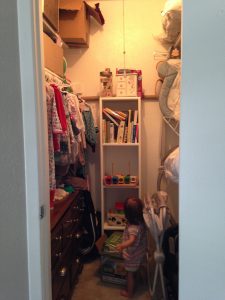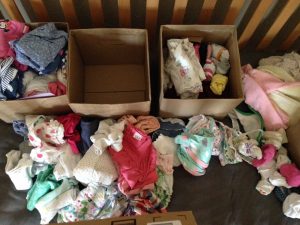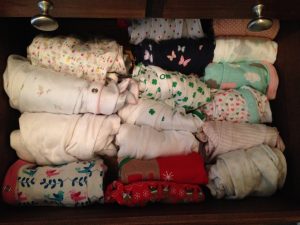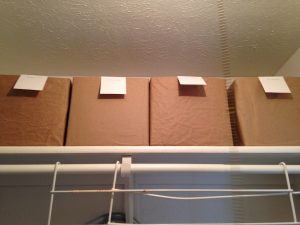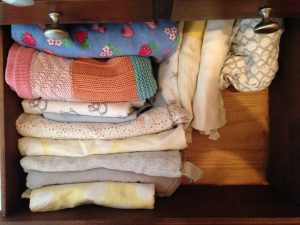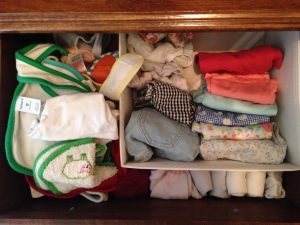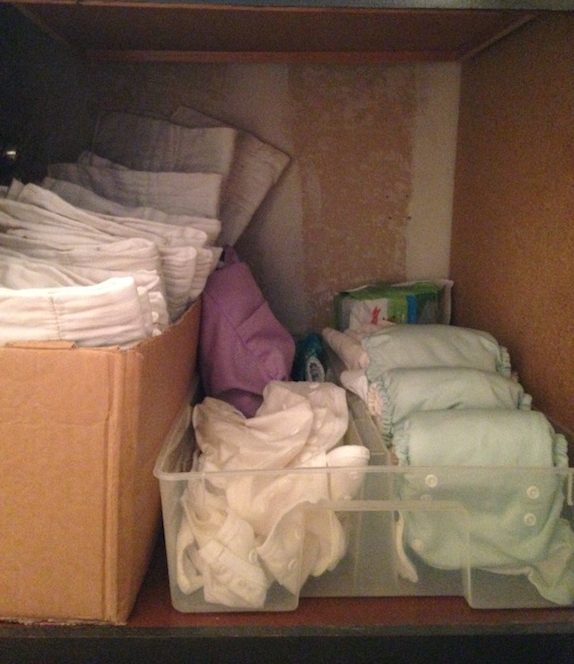The time is here. I finally tidied the baby clothes, and included cloth diapers as well.
Once upon a time, I was pregnant and we moved across the Atlantic. In a largely empty apartment, while we waited for our things to ship, I exercised my desire to organise and decorate in the baby’s bedroom closet. I collected a little stock of baby clothes, neatly hung and folded. It was a beautiful little space I loved stepping into, with serene white walls, and impossibly tiny clothes waiting for little someone to fill them.
Then chaos overtook. That peaceful space became this:
KonMari attempt number one: Starting out, my plan was to tackle this tidying project while Edith was awake, since I wanted access to her room and preferred to do the discarding there, instead of hauling everything to another part of the house and then back again. I tried to concoct a little work area in her crib to be out of her reach. This whole plan was a mistake. She reached through the crib and grabbed things, strewing them around and undoing my work as I was doing it. Consequently, I was rushing, wasting time gathering and re-gathering things into piles, and the clock was ticking towards 5 o’clock and the dinner hour and she was getting fussy from my lack of attention.
By the time Mike got home, I was scrambling to get everything put away and make dinner, and I didn’t feel good about the decluttering decisions I’d made or any sense of peace about the end result. The moral: Marie Kondo is right that you should tidy in peace and quiet, and preferably alone. I reflected, after this, that part of the purpose of tidying this way isn’t just to deal with the physical space, but to gain a new perspective through the process, and this kind of learning requires the ability to think and process your feelings along the way.
Kenmore attempt number two: On the weekend, Mike took Edith out for a while so I could work in peace. BLISS! This time, I was much more successful. The spaces I organised became clear and peaceful. I also felt much more at peace with what I chose to keep and learned some lessons as I worked.
One pocket of clothing in Edith’s closet was a group of my childhood clothes. I didn’t address these on the first round, because they weren’t registering as a problem to me and of course I was rushing. I balked at doing them the second time around, but felt obliged. What I discovered immediately was that, although the bundle of clothes was small, a few items I thought I wanted to keep, when I actually looked through them I felt very differently. These were a selection of childhood clothes, kept by my mom as particularly special, but about half of them didn’t resonate with me at all any more. Since they were also threadbare and out of date, I felt bad keeping them for Edith. After discarding these items that I had no feeling for, those that were left emerged clearly as my own keepsakes. Keeping them in her closet was really just a way of avoiding my own responsibility for them.
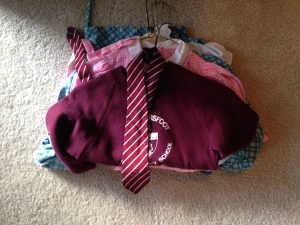
The lessons I learned here were, first, that it really is important to be thorough, because what you perceive as the source of a mess may not be the whole cause; and second, that sorting through things this way is a means of discovering where you have been dishonest with yourself, categorising things in a way just to avoid admitting that they are really your own responsibility.
When I went through all Edith’s clothes this second time, I discarded a few more – but not a lot. I ended up with a small bag of items which I ultimately donated to a pregnancy center. As I’ve experienced several times now, my discard pile didn’t look big enough to make a difference, but when I put everything away again it all fit much more neatly than it had previously.
I did reorganise things when I put them away again. The problem I have always had with Edith’s clothes is that she is constantly moving through sizes – though thankfully she now stays longer in a size than she used to. I tried to keep boxes for each size of clothing and then move things into drawers and hangers as they became ‘current’, but even this is a sloppy system because plenty of clothes fit beyond the boundaries of their stated size. For pyjamas in particular she has always seemed to wear them longer than other types of clothing. I decided to make pyjamas their own subcategory and give them all a single drawer, irrespective of size, though of course I arranged them from small to large.
For other ‘past’ sizes of clothes, I covered some old diaper boxes in brown paper and filled them with folded clothes. They sit on a high shelf in the closet, with size labels. Like most parents who may have multiple children, I had a quandary about what to keep. In the end, I decided not to overthink. I simply kept the clothes which, when I held them, gave me happy memories of my little baby wearing them. A future baby may wear them, or may not, depending. It was really a relief to be free of the need to strategise about an unknown future. I simply kept the baby clothes which I felt I wanted to keep, right now.
A testament to the KonMari method of folding here is the drawer of blankets. I didn’t discard more than one or two, but the formerly messy drawer now has empty space.
However, I did not fold the bibs. I started out trying, but it was just too maddening, for something we are constantly adding and removing. I love folding most things and I think it usually creates more space – but not here, for some reason. Sorry, KonMari.
And now, for a breath of fresh air, the closet now:
In addition to this, I sorted out our cloth diaper collection. Partly it was because it desperately needed it, but also because Marie Kondo is always recommending grouping things by material – and since both clothes and cloth diapers are fabric, they seemed a natural pairing for one day’s work. My cloth diaper stash was initially split between the baby’s room and the cabinet in the bathroom – keeping ‘in use’ diapers from the ‘not in use’ ones. But Kondo generally advises against this kind of separation unless it’s totally necessary, so now all the diapers are housed under the sink. The prefolds are vertical in a box, covers (like bibs) not folded but just scrunched, and a few all-in-ones stored vertically on the right. In the back are a few smaller size diapers, extra wipes, and a rolled-up bin liner. If these cloth diaper terms mean nothing to you, don’t worry about it. You probably have more interesting things to think about!
I don’t apologise for the poor lighting, or the slight disorder of my prefolds, or the ugly back of my cabinet. I hope you know that if you want perfect beauty, you can read a magazine! I think the whole point of a blog is that it is somewhat spontaneous and informal.
So that’s the report on the baby clothes and diapers. After a few weeks’ break I now have a bit more time, and am planning to return to the Komono tasks still remaining, the next of which will be our medicines and vitamins.
